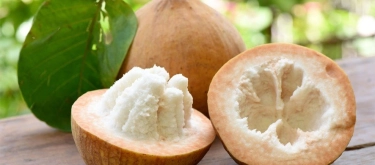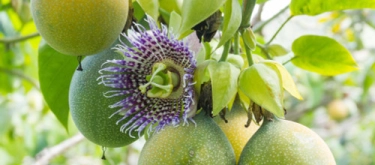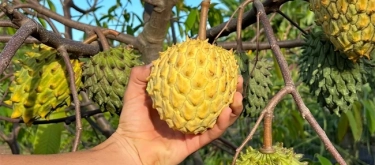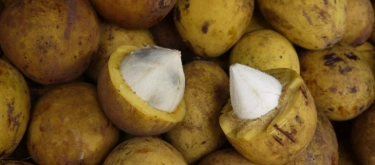Gac Fruit: Taste Profile, Aroma, Benefits and Health Risks
Gac Fruit (Momordica cochinchinensis) is a vibrant tropical fruit native to Southeast Asia, particularly valued in Vietnam, Thailand, and China. Known for its remarkable nutritional properties and vivid color, gac fruit is traditionally used in culinary preparations and medicinal practices.
Gac fruit is generally safe, but individuals sensitive to cucurbits may experience allergic reactions.
What does Gac Fruit taste like?

Complete Sensory Description:
-
Taste: Gac fruit has a mildly sweet and slightly vegetal taste, resembling a subtle blend of avocado, pumpkin, and carrot, often described as refreshing yet earthy.
-
Aroma: The fruit emits a delicate, mildly fruity aroma with subtle vegetal undertones.
-
Texture: The pulp is soft, buttery, and creamy, surrounding large, flat seeds encased in red, gelatinous arils.
-
Appearance: Large, round or oval fruit with thick, spiky skin that transitions from green to vibrant orange or deep red upon ripening. The interior reveals vibrant red pulp with visually striking seeds.
In-depth Flavor Analysis:
The mild sweetness of gac fruit derives from natural sugars such as fructose and glucose, complemented by earthy, vegetal notes provided by carotenoids and antioxidants. Ripeness significantly influences flavor, with younger fruits having a more vegetal, less sweet profile, while fully ripe fruits offer a sweeter, richer, and more balanced taste. Processing or cooking gac fruit, such as steaming or pureeing, typically enhances sweetness and reduces vegetal notes, making it more palatable for various culinary applications.
Flavour Variations Depending on Preparation and Ripeness:
-
Ripeness: Immature gac fruits exhibit stronger vegetal flavors with minimal sweetness, while ripe fruits become sweeter, milder, and less vegetal.
-
Preparation: Steaming, boiling, or blending the pulp often enhances sweetness, diminishing raw, vegetal undertones. Incorporation into sweet dishes or beverages emphasizes the fruit’s delicate sweetness.
Varieties and Culinary Applications:
Gac fruit does not have widely recognized distinct varieties, but regional growing conditions may produce slight flavor variations. Traditionally used in rice dishes like Vietnamese "Xôi Gấc," gac imparts a distinctive red-orange color and subtle sweetness. It is also popular in smoothies, desserts, sauces, and health beverages due to its high nutritional value.
Selection and Storage:
Choose gac fruit that feels heavy for its size, with firm, vibrant skin indicating peak ripeness. Unripe fruits can be ripened at room temperature. Once ripe, store gac fruit refrigerated to maintain freshness for a few days. The pulp can be frozen for long-term storage, preserving its nutritional benefits.
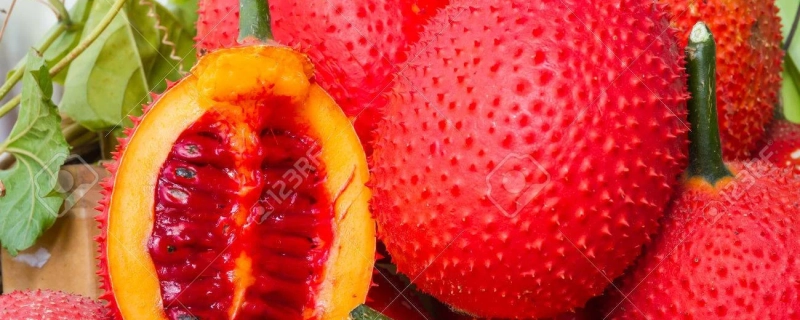
Nutritional Insights:
Gac fruit is exceptionally high in lycopene and beta-carotene, potent antioxidants beneficial for eye health, skin vitality, and immune function. It also contains significant amounts of vitamin E and essential fatty acids, contributing to cardiovascular health and anti-inflammatory properties.
Expert Insights & Culinary Tips:
Chefs recommend incorporating gac fruit into dishes where its vibrant color and mild sweetness can enhance both taste and presentation, such as rice dishes, smoothies, or desserts. Pairing gac fruit with coconut milk, honey, or citrus fruits effectively balances its flavor profile and nutritional benefits.
Interesting and Curious Facts:
-
Known as the "Fruit from Heaven" in Vietnam due to its auspicious color and health benefits.
-
Traditionally consumed during celebrations like weddings and lunar festivals for good luck and prosperity.
-
Gac oil, extracted from its seeds and pulp, is widely used in skincare products due to its high antioxidant content.
Harm and Dietary Considerations:
Excessive consumption is rare but may cause digestive discomfort due to its richness. Allergies, although uncommon, may occur in individuals sensitive to fruits in the cucurbit family. Moderate consumption is advisable.
Religious Dietary Considerations:
Gac fruit is universally accepted in all major religious dietary practices without known restrictions.
Final Thoughts & Sensory Journey:
Gac fruit offers a unique sensory experience with its mild sweetness, buttery texture, and vibrant color. Beyond its culinary appeal, its exceptional nutritional profile positions it as a remarkable addition to global dietary habits.
Resources:
-
"Tropical and Subtropical Fruits: Postharvest Physiology, Processing, and Nutrition" by Muhammad Siddiq and Jiwan S. Sidhu (2012).
-
"Asian Foods: Science and Technology" by Catharina Y.W. Ang and Keshun Liu (1999).
-
"Handbook of Fruit and Vegetable Flavors" by Y.H. Hui (2010).



